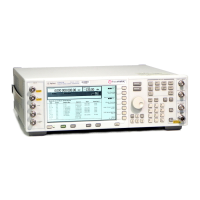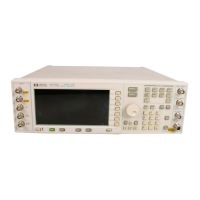190 Chapter 4
Basic Digital Operation
User-Defined I/Q Maps
Storing a User-Defined I/Q Map File
In this example, you learn how to store a user-defined I/Q map. If you have not created a user-defined I/Q
map, complete the steps in the previous sections, “Accessing and Clearing the I/Q Table Editor” on page
188 and “Entering I and Q Values” on page 189.
1. Press
More (1 of 2) > Load/Store > Store To File.
If there is already a file name from the Catalog of IQ Files occupying the active entry area, press
the following keys:
Edit Keys > Clear Text
2. Enter a file name (for example, NEW4QAM) using the alpha keys and the numeric keypad.
The maximum file name length is 23 characters.
3. Press
Enter.
The user-defined I/Q map is now stored in the Catalog of IQ Files.
Moving I/Q Symbols
Use the following procedure to manipulate symbol locations to simulate magnitude and phase errors. In this
example, you edit a 4QAM constellation to move one symbol closer to the origin.
Loading the Default 4QAM I/Q Map
1. Press
Preset.
2. Perform the following keypress sequence required for your format type.
For Custom Format
Press
Mode > Custom > Real Time I/Q Base Band > Modulation Type > Define User I/Q >
More (1 of 2) > Load Default I/Q Map > QAM > 4QAM.
For TMDA Formats
Press
Mode > TDMA > desired format > More (1 of 2) > Modify Standard > Modulation Type > Define User I/Q >
More (1 of 2) > Load Default I/Q Map > QAM > 4QAM.
This loads a default 4QAM I/Q modulation into the I/Q Values table editor.

